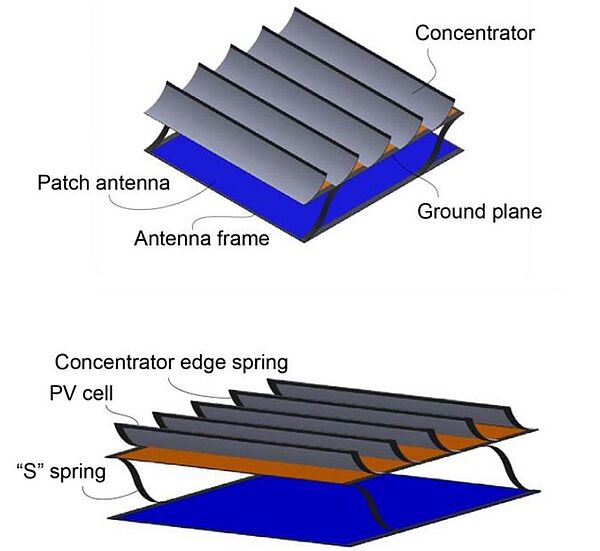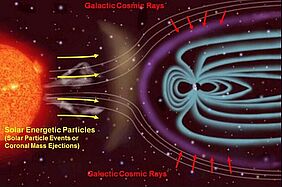Aenert. Research Laboratory news
Harnessing solar radiation in an efficient and also economical manner is one of the chief interests of today’s energy industry. Alongside conventional silicon panels, perovskites have gradually come into the crosshairs of scientific attention as they are relatively low-cost, lightweight and easily deposited onto most surfaces, including flexible and textured ones. This, as well as the fact that they have the potential for achieving efficiencies similar to those of current space PV technologies, makes them particularly suitable for space applications. Just as on Earth, in space also perovskite solar cells need to have suitable durability. However, the environment there is vastly different. On Earth the most challenging issues are related to the weather, in space perovskites must deal with the problems stemming from radiation bombardment and extreme temperature swings. Therefore, materials used in such spacecraft have to exhibit very high resistance not only to ensure their proper function but also because launching costs of space objects are expensive. So far, perovskites have proved to be more tolerant to radiation than many other solar cells, but plenty of testing remains to be conducted.
Now (2023), scientists at the National Renewable Energy Laboratory have demonstrated what effect exposure to radiation in space would have on perovskites. They found that the next-generation perovskites would work in space but also stressed the necessity to encapsulate the cell in some way to provide enhanced protection. The research is the most recent effort to determine the effectiveness of perovskites for use in space applications, where they would be exposed to protons, alpha particles, atomic oxygen, and other stressors.
Continued research revealed that a micron-thick layer of silicon oxide would preserve the efficiency and increase the lifetime of perovskite solar cells in space. The silicon oxide layer would reduce the weight of conventional radiation barriers used for other solar cells by more than 99% and mark the beginning of designing lightweight and low-cost packaging for perovskites.
The abundant low-energy protons pose a particular problem for perovskites in space because they can knock atoms out of place and cause efficiency levels to steadily decline. These protons could interact with matter more easily. The ensuing damage, however, could be averted by adding a silicon layer.
Moreover, the scientists also tested the potential benefits of the barrier in more conventional applications by exposing the perovskite solar cells to an uncontrolled moisture and temperature environment for several days to mimic storage conditions. Also, the perovskite solar cells were bombarded with ultraviolet photons similar to the environment at low-Earth orbit. The protected cells retained their initial 19% efficiency. The unprotected cells exhibited a significant decrease in efficiency, from 19.4% to 10.8%. The oxide layer also provided protection when other perovskite compositions typically more sensitive to moisture were exposed to water.
There have been many efforts in the past to harness the potential of perovskites. In 2021, scientists tested an all-perovskite tandem photovoltaic (PV) technology having an ultrathin active layer (1.56 µm) and offering high power conversion efficiency. As proved by the study, all-perovskite tandems were found to have a high tolerance to the harsh radiation environment in space. The tests under 68 MeV proton irradiation exhibited negligible degradation (<6%) at a dose of 1013 p+ cm−2 where even commercially available radiation-hardened space PV degrade >22%. High spatial resolution photoluminescence (PL) microscopy revealed that defect clusters in GaAs were mainly to blame for the degradation of current space-PV whereas negligible reduction in PL of the individual perovskite subcells even after the high doses was observed. When the intensity-dependent PL of bare low-gap and high-gap perovskite absorbers was analysed, the scientists found that the VOC, fill factor, and efficiency potentials remain identically high after irradiation. Radiation damage of all-perovskite tandems thus has a fundamentally different origin to traditional space PV.
Image: Potential of all-perovskite tandem solar cells. a) Sketch of an all-perovskite tandem solar cell (perovskite 2J) comprising FACsDMAPbIBr and FACsPbSnI based perovskite as high-gap and low-gap absorbers, respectively. b) Overview of the efficiency, weight, and specific power potential of perovskite-based 1J, 2J (all perovskite and perovskite/CIGS), and 3J PV based on state-of-the-art small-area lab-scale record efficiencies and realistic efficiency potentials derived from today's materials, corresponding to ≈70% SQ limiting efficiency
Source: Felix Lang, Giles E. Eperon, Kyle Frohna, Elizabeth M. Tennyson, Amran Al-Ashouri, Georgios Kourkafas, Jürgen Bundesmann, Andrea Denker, Kevin G. West, Louise C. Hirst, Heinz-Christoph Neitzert, Samuel D. Stranks/ Proton-Radiation Tolerant All-Perovskite Multijunction Solar Cells/ Advanced Energy Materials, Volume 11, Issue 41, November 4, 2021/ doi.org/10.1002/aenm.202102246/ Open Source This is an Open Access article is distributed under the terms of the Creative Commons Attribution 4.0 International (CC BY 4.0)
In 2022, a novel design was contrived for a lightweight, high-performance space-based solar power array combined with power beaming capability for operation in geosynchronous orbit and transmission of power to Earth. To achieve this, a modular configuration of small, repeatable unit cells able to individually perform power collection, conversion, and transmission was installed. Lightweight parabolic concentrators were set up to collect sunlight and convert it to DC electric power with high efficiency III-V photovoltaics. Several CMOS integrated circuits within each tile generated and controlled the phase of multiple independently-controlled microwave sources using the DC power. The sources were linked to radiating antennas which had the function of elements of a large-phased array to beam the RF power to Earth. The power was sent to Earth at a frequency in the range of 1-10 GHz and collected with ground-based rectennas. The outcome of the experiment was that significantly reduced mass was achieved compared to previous designs by means of solar concentration, current CMOS integrated circuit technology, and ultralight structural elements. The resulting satellite had no movable parts once fully deployed and all beam steering was done electronically. The design had an areal mass density of 160 g/m2 and an end-to-end efficiency of 7-14%.
Image: Schematic of general modular tile architecture
Source: Behrooz Abiri, Manan Arya, Florian Bohn, Austin Fikes, Matan Gal-Katziri, Eleftherios Gdoutos, Ashish Goel, Pilar Espinet Gonzalez, Michael Kelzenberg, Nicolas Lee, Michael A. Marshall, Tatiana Roy, Fabien Royer, Emily C. Warmann, Nina Vaidya, Tatiana Vinogradova, Richard Madonna, Harry Atwater, Ali Hajimiri, Sergio Pellegrino/ A Lightweight Space-based Solar Power Generation and Transmission Satellite/ Cornell University, Astrophysics, Instrumentation and Methods for Astrophysics/ doi.org/10.48550/arXiv.2206.08373/ Open Source This is an Open Access article is distributed under the terms of the Creative Commons Attribution-NonCommercial-ShareAlike 4.0 International (CC BY-NC-SA 4.0)
There are several benefits related to coating perovskite cells with an extra protective layer: It was found that while exposure to a larger concentration of low-energy protons caused unprotected perovskite solar cells to get destroyed, the protected perovskites demonstrated what the scientists described as “a remarkable resilience.” Owing to the simple barrier, the cells showed no damage. In addition, since perovskite solar cells can be deposited onto any flexible substrate, the new technology, in combination with the protective layer of silicon oxide, allows them to be used for various terrestrial applications such as powering drones. Power conversion efficiency and operational stability of perovskite solar cells have been the two primary focus areas for the community so far. We have made a lot of progress and I think we have come far to the point that we might be pretty close to hitting those targets needed for industrialization. However, to really enable this market entry, packaging is the next target.
So far, the main focus of this research lay on power conversion efficiency and operational stability of perovskite solar cells. In order to be able to launch the perovskite cell onto the market, the scientists will devote their attention to matters of packaging next. If successful, there might soon be an efficient and economical way to power space applications.
By the Editorial Board
